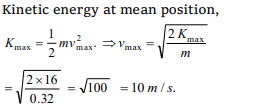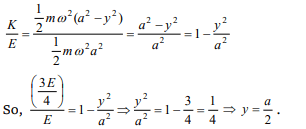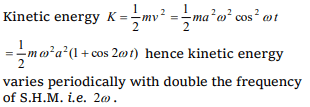1. Displacement between maximum potential energy
position and maximum kinetic energy position for
a particle executing S.H.M. is
a) -a
b) +a
c) \[\pm a\]
d) \[\pm \frac{a}{4}\]
Explanation:


2.When a mass M is attached to the spring of force
constant k, then the spring stretches by l. If the
mass oscillates with amplitude l, what will be
maximum potential energy stored in the spring
a) \[\frac{kl}{2}\]
b) 2 kl
c) \[\frac{1}{2}Mgl\]
d) Mgl
Explanation:

3.The potential energy of a simple harmonic
oscillator when the particle is half way to its end
point is (where E is the total energy)
a) \[\frac{1}{8}E\]
b) \[\frac{1}{4}E\]
c) \[\frac{1}{2}E\]
d) \[\frac{2}{3}E\]
Explanation:

4. A body executes simple harmonic motion. The
potential energy (P.E.), the kinetic energy (K.E.)
and total energy (T.E.) are measured as a function
of displacement x. Which of the following
statements is true
a) P.E. is maximum when x = 0
b) K.E. is maximum when x = 0
c) T.E. is zero when x = 0
d) K.E. is maximum when x is maximum
Explanation: In S.H.M., at mean position i.e. at x = 0 kinetic energy will be maximum and pE will be minimum. Total energy is always constant.
5.If <E> and <U> denote the average kinetic and
the average potential energies respectively of
mass describing a simple harmonic motion, over
one period, then the correct relation is
a) <E> = <U>
b) <E> = 2<U>
c) <E> = – 2<U>
d) <E> = – <U>
Explanation:

6.The total energy of a particle, executing simple
harmonic motion is
a) \[\propto x\]
b) \[\propto x^{2}\]
c) Independent of x
d) \[\propto x^{1/2}\]
Explanation:

7. The kinetic energy of a particle executing S.H.M.
is 16 J when it is at its mean position. If the mass
of the particle is 0.32 kg, then what is the
maximum velocity of the particle
a) 5m / s
b) 15m / s
c) 10 m / s
d) 20 m / s
Explanation:

8. A particle starts simple harmonic motion from the
mean position. Its amplitude is a and total energy
E. At one instant its kinetic energy is 3 E / 4. Its
displacement at that instant is
a) \[a/\sqrt{2}\]
b) \[a/2\]
c) \[\frac{a}{\sqrt{3/2}}\]
d) \[a/\sqrt{3}\]
Explanation:

9. A particle executes simple harmonic motion with
a frequency f . The frequency with which its
kinetic energy oscillates is
a) f/2
b) f
c) 2 f
d) 4 f
Explanation:

10. The amplitude of a particle executing SHM is
made three-fourth keeping its time period
constant. Its total energy will be
a) \[\frac{E}{2}\]
b) \[\frac{3}{4}E\]
c) \[\frac{9}{16}E\]
d) None of these
Explanation:
